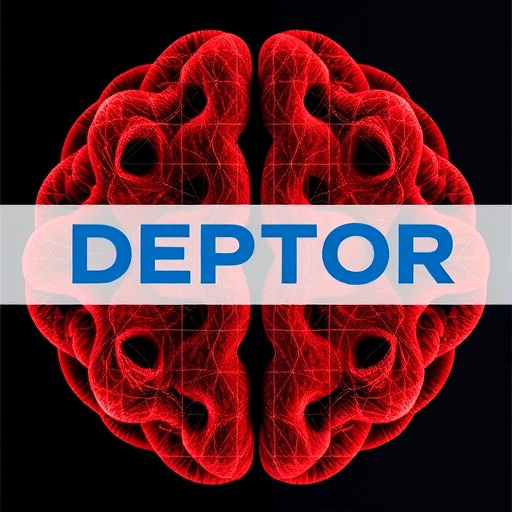In an era where the global burden of degenerative spine diseases profoundly impacts millions, a groundbreaking study has emerged, elucidating a critical molecular pathway that holds promise for novel therapeutic interventions. The investigation, spearheaded by Lu, Liu, Wang, and collaborators, meticulously delves into the cellular intricacies governing intervertebral disk degeneration (IVDD), revealing a pivotal regulatory role for the protein DEPTOR in nucleus pulposus cell senescence. Their findings dissect the interplay between DEPTOR and the mTORC1/S6K1/ATG1 signaling cascade, offering unprecedented insights into the cellular aging processes that precipitate disk degeneration and potential avenues for its alleviation.
IVDD, a leading cause of chronic back pain and mobility impairment worldwide, stems primarily from the progressive deterioration of the intervertebral disk’s nucleus pulposus (NP) cells, which maintain disk integrity and function. Senescence of these cells triggers extracellular matrix degradation, inflammation, and biomechanical dysfunction, culminating in debilitating structural failure. However, the molecular mechanisms driving NP cell senescence and their modulation have remained elusive, hampering targeted therapeutic development. This study’s comprehensive characterization of DEPTOR’s role bridges that knowledge gap with transformative implications.
At the molecular heart of these cellular events lies the mechanistic target of rapamycin complex 1 (mTORC1), a central nutrient and energy sensor curating a wide spectrum of anabolic and catabolic responses. The research highlights how DEPTOR serves as an endogenous inhibitor of mTORC1 activity within NP cells, intricately controlling downstream effectors such as ribosomal protein S6 kinase beta-1 (S6K1) and autophagy-related gene 1 (ATG1). Through fine-tuned modulation of these molecules, DEPTOR emerges as a crucial gatekeeper that delays NP cell senescence, thereby preserving intervertebral disk homeostasis.
Experimental data from cellular and animal models reveal a profound decrease in DEPTOR expression correlating with advanced disk degeneration stages. Restoring DEPTOR levels effectively attenuated mTORC1 hyperactivation, normalized S6K1 signaling, and reactivated ATG1-mediated autophagic flux, rejuvenating cellular health. This cascade correction alleviated senescent markers and prevented extracellular matrix breakdown, illustrating the therapeutic potency of targeting the DEPTOR-mTORC1 axis.
The study utilized advanced techniques such as RNA interference, western blotting, immunofluorescence, and senescence-associated β-galactosidase staining to meticulously delineate the mechanistic framework. Additionally, transgenic mouse models with conditional DEPTOR knockdown in NP cells recapitulated accelerated disk degeneration phenotypes, underscoring physiological relevance. Conversely, DEPTOR overexpression restored disk structure and function, reinforcing its candidacy as a molecular shield against IVDD.
Intriguingly, the investigation sheds light on the autophagy pathway governed by ATG1 as a downstream sentinel that mediates DEPTOR’s protective effects. Autophagic degradation clears damaged organelles and protein aggregates, mitigating cellular stress and senescence. By reinstating autophagic activity via ATG1, DEPTOR ensures cellular longevity and functional resilience of NP cells, revealing autophagy modulation as a critical therapeutic target.
This revelation aligns with burgeoning evidence positioning mTOR pathway dysregulation at the fulcrum of various age-related pathologies beyond IVDD, including neurodegeneration, metabolic syndromes, and cancer. Hence, modulating DEPTOR to harmonize mTORC1 signaling and autophagy could have far-reaching implications for regenerative medicine and age-related disease management.
Moreover, the translational potential of these findings is amplified by their implications for drug development. Targeting DEPTOR or its downstream effectors with small molecules, peptides, or gene therapy vectors could revolutionize current IVDD treatments, which largely rely on symptomatic relief or surgical interventions with variable success rates. The molecular precision offered by this approach promises improved efficacy and reduced side effects.
The authors emphasize the necessity of further research to optimize DEPTOR-targeted strategies, explore combinatorial therapy with autophagy enhancers, and investigate longitudinal effects in human subjects. Such endeavors could pave the way for personalized medicine approaches tailored to patients’ molecular profiles and disease stages, enhancing clinical outcomes markedly.
Additionally, the study’s findings may catalyze a paradigm shift in understanding the senescence-autophagy interplay, fostering multidisciplinary research to unravel complex cellular aging mechanisms underpinning musculoskeletal health. By elucidating how a single molecular entity modulates intersecting pathways, the research sets a precedent for innovative investigations into other degenerative diseases.
The broader significance of this work lies not only in its scientific novelty but also in its potential to mitigate a pervasive public health challenge. IVDD imposes significant economic and social burdens globally, limiting quality of life and productivity for affected individuals. Interventions arising from this research could transform patient care, reducing disability and healthcare costs substantially.
In summary, the research conducted by Lu, Liu, Wang, et al. unveils DEPTOR as a master regulator of NP cell senescence through its orchestration of the mTORC1/S6K1/ATG1 axis, highlighting an elegant molecular mechanism to counteract intervertebral disk degeneration. This discovery charts a promising path forward in the quest to develop disease-modifying therapies for IVDD, positioning the DEPTOR-mTORC1 pathway at the forefront of regenerative and anti-aging biomedical research.
As the scientific community continues to grapple with the complexities of cellular aging and degeneration, such landmark studies illuminate critical molecular targets and pathways, inspiring hope for breakthroughs that could ultimately restore spinal health and function to millions worldwide. The integration of molecular biology, cell signaling, and clinical translation evidenced here exemplifies the future of precision medicine in combating degenerative conditions.
Ultimately, this work not only advances our understanding of spine biology but also elevates the dialog on how intricate intracellular networks govern tissue aging and disease, heralding a new era of molecular therapeutics designed to extend health span and improve life quality across populations.
Subject of Research: Regulation of nucleus pulposus cell senescence via the DEPTOR-mediated mTORC1/S6K1/ATG1 signaling pathway to mitigate intervertebral disk degeneration.
Article Title: DEPTOR regulates nucleus pulposus cell senescence through the mTORC1/S6K1/ATG1 pathway to alleviate intervertebral disk degeneration.
Article References:
Lu, H., Liu, Z., Wang, Y. et al. DEPTOR regulates nucleus pulposus cell senescence through the mTORC1/S6K1/ATG1 pathway to alleviate intervertebral disk degeneration. Cell Death Discov. 11, 533 (2025). https://doi.org/10.1038/s41420-025-02819-9
Image Credits: AI Generated
DOI: 17 November 2025




